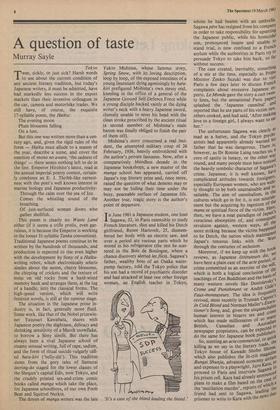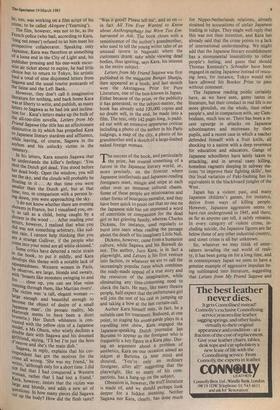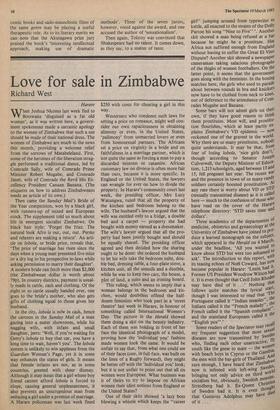A question of taste
Murray Sayle
Tokyo
Twee, sickly, or just sick? Harsh words to use about the current condition of any ancient literary tradition, but today's Japanese writers, it must be admitted, have had markedly less success in the export markets than their inventive colleagues in the car, camera and motorbike trades. We still have, of course, the exquisite 17-syllable poem, the Haiku:
The evening moon Plum blossoms falling On a lute.
But this one was written more than a cen- tury ago, and, given the rigid rules of the
form — Haiku must allude to a season of the year, describe a scene, and cover the emotion of mono no aware, 'the sadness of things' — there seems nothing left to do in the line. Emperor Hirohito's latest, read at the annual imperial poetry contest, certain- ly combines an E. J. Thribb-like earnest- ness with the poet's well known interest in marine biology and Japanese productivity:
Through the calm over the sea of Izu Comes the whistling sound of the breathing Of just-surfaced women divers who gather shellfish.
This poem is clearly no Waste Land either (if it seems a trifle prolix, even gar- rulous, it is because the Emperor is working in the looser 31-syllable Tanka convention). Traditional Japanese poems continue to be written by the hundreds of thousands, and production is expected to rise even higher with the development by Sony of a Haiku- writing robot, which electronically selects similes about the moon, cherry blossoms, the chirping of crickets and the texture of moss on old rocks from a hard-wired memory bank and arranges them, at the tug of a handle, into the classical forms. The high-speed version, which will write feminist novels, is still at the rumour stage.
The situation in the Japanese prose in-
dustry is, in fact, generally more fluid. Some work, like that of the Nobel prizewin- ner Yasunari Kawabata, shares with Japanese poetry the slightness, delicacy and shrinking sensitivity of a March snowflake, to borrow a Sony simile. But there has always been a rival Japanese school of steamy sensual writing, full of rape, sadism, and the form of ritual suicide vulgarly call- ed hara-kiri ('belly-slit'). This tradition stems from the gory tales of Samurai derring-do staged for the lower classes of the Shogun's capital Edo, now Tokyo, and the crudely printed sex-and-crime comic books called manga which take the place, for Japanese schoolboys, of our own Pooh Bear and Squirrel Nutkin.
The doyen of manga writers was the late Yukio Mishima, whose famous story, Spring Snow, with its loving description, loop by loop, of the exposed intestines of a young lieutenant dying agonisingly by hara- kiri prefigured Mishima's own messy end, kneeling in the office of a general of the Japanese Ground Self-Defence Force while a young disciple hacked vainly at the dying writer's neck with a heavy Japanese sword, clumsily unable to sever his head with the clean stroke prescribed by the ancient ritual (a second member of Mishima's male harem was finally obliged to finish the pair of them off).
Mishima's story concerned a real inci- dent, the attempted military coup of 26 February, 1936, heavily embroidered with the author's private fantasies. Now, after a comparatively bloodless decade in the Japanese bookshops, a new master of the manga school has appeared, carried off Japan's top literary prize and, once more, raised the question of what demons may or may not be biding their time under the busy, peaceable surface of Japanese life. Another true, tragic story is the author's point of departure.
In June 1981 a Japanese student, one Issei Sagawa, 32, in Paris ostensibly to study French literature, shot and killed his Dutch girlfriend, Renee Hartevelt, 25, dismem- bered her body with an electric saw, and over a period ate various parts which he stored in his refrigerator (the rest he scat- tered in the Bois de Boulogne, where a chance discovery alerted lesflics). Sagawa's father, wealthy boss of an Osaka water- pump factory, told the Tokyo police that his son had a record of psychiatric disorder and had attacked at least one other foreign woman, an English teacher in Tokyo,
'It's a case of the bland leading the bland.'
whom he had beaten with an umbrella. Sagawa pere has resigned from his company in order to take responsibility for upsetting the Japanese public, while his homicidal son, pronounced insane and unable t° stand trial, is now confined to a French asylum while the authorities in Paris try to persuade Tokyo to take him back, so far without success.
The case created, inevitably, something
of a stir at the time, especially as Prime Minister Zenko Suzuki was due to visit Paris a few days later to discuss French complaints about excessive Japanese ex- ports. Le Monde gave the story a curt twen- ty lines, but the sensational Paris papers splashed the 'Japanese cannibal' and reported that he ate parts of his victim raw' others cooked, and had said, 'After making love to a foreign girl, I always want to eat her.'
The unfortunate Sagawa was clearly as
mad as a hatter, and the Tokyo psYell.' atrists had apparently already warned 10 father that he was dangerous. There is, however, as Dr Ronnie Laing teaches us, a core of sanity in lunacy, or the other waY, round, and many people must have noticed the heavily symbolic character of Sagawa's crime. Japanese, it is well known, have complicated attitudes towards foreigners' especially European women, who are wide" ly thought to be both unattainable and in- satiable. The aim of cannibalism, in the cultures which go in for it, is not nourish- ment but the acquiring by ingestion of the mana or spiritual force of the victim. He then, we have a neat paradigm of Japan St voracious absorption of, and conseclueli revulsion against, western ways, all the ci more striking because the victim happen,, be Dutch, the nation which maintaineu Japan's tenuous links with the West through the centuries of seclusion. Moreover, if we keep up with the b0oke reviews, as Japanese litterateurs do, we have here a plain case of the acte gratuit,, crime committed as an exercise of the 'ill' the teachings is both a logical conclusion of En', teachings of Zen Buddhism and the basis 0,1_ many western novels like DostoievskY,ss Crime and Punishment or Andre Gide,,, Faux-monnayeurs. The idea is frequenbis revived, most recently in Truman Capote,, In Cold Blood and Norman Mailer's Exec,u,e tioner's Song, and, given the unquenchable human interest in bizarre sex and crime which has made millionaires of so many British, Canadian and Australiro newspaper proprietors, can be expected s. do do the same for Japanese book publisheil So, scenting an acte commercial, or Or:
killing as we say in the literary
Tokyo house of Kawade Shobo Shin:snae which also publishes the lit-crit niagaflare Bungei Shunju, advanced economy air' to and expenses to a playwright, Juro Kara, in proceed to Paris and interview Sagawaced trade, fl_C, his prison cell. Kara had already announ of plans to make a film based on the case, the 'mutilation murder', reports of which friend had sent to Sagawa, leading "' prisoner to write to Kara with the new thaE he, too, was working on a film script of his crime, to be called Akogare ('Yearning').
The film, however, was not to be, as the French police (who had, according to Kara, long red noses') refused to let him meet his Prospective collaborator. Speaking only Japanese, Kara was therefore at something of a loose end in the City of Light and, his Publisher pressing and his one-week excur- sion air ticket about to expire, he had little choice but to return to Tokyo, his artistic haul a total of nine disjointed letters from Sagawa and the usual tourist postcards of the Seine and the Left Bank. However, they don't call it imaginative literature for nothing, and back home Kara
Was at liberty to write, and publish, as many letters to Sagawa as he had ink and inclina-
tion for . Kara's letters make up the bulk of
the all-too-slim novella, Letters from My Friend Sagawa (the title has an affectionate diminutive in it) which has propelled Kara to Japanese literary stardom and affluence, while leaving, of course, Sagawa in the asylum
and his unlucky victim in the
cemetery. In his letters, Kara assures Sagawa that
he understands the killer's feelings: 'You shot the Dutch girl dead. You stood before her dead body. Open the window, you will
floating the sky, and the clouds will probably be floating in it ... At that time you were
smaller than the Dutch girl, but at that rune, too, in comparison with a person ly- ing down, you were approaching the sky.
'I do not know whether there are evening showers in France, but I visualised you, on- ly as tall as a child, being caught by a shower in the wood ... After reading your letters, however, I realised that what you did was not something arbitrary, like sud- den rain. I cannot help thinking that you
are a strange Gulliver, if the people who come into your mind are all white-skinned.'
Some critics have detected a racist strain 1,11 the book, to put it mildly, and Kara develops this theme with a notable lack of squeamishness. Western women in Paris, he observes, are large, blonde and sweaty, With 'breasts like monsters swinging to and fro . close up, you can see blue veins
The through them, like Martian rivers'. .1 he victim was 'a tall, elegant woman -
large enough and beautiful enough to become the object of desire of a small
Japanese man'. (In prosaic reality, Ms brunette.) seems to have been a short Her Dutch whiteness is con- trasted with the yellow skin of a Japanese model, a Ms Ohara, who wisely declines a
double date with Sagawa and his doomed girlfriend, saying, bet I'm just the hors d'oeuvre and she's the main dish.' Sagawa, in reply, explains that his cor- respondent has got the motives for the
crime e all wrong. 'She was my friend,' he writes, 'although only for a short time. I did not feel that I had conquered a Western woman rather that I had lost a friend.'
ra, however, insists that the victim was large and blonde, and adds a new set of estions: In how many pieces did Sagawa alit up the body? How did the flesh taste? `Was it good? Please tell me', and so on in fact All You Ever Wanted to Know about Anthropophagy but Were Too Em- barrassed to Ask. The book closes with a reminiscence of the author's grandmother, who used to tell the young writer tales of an unusual tavern in Nagasaki where the customers drank sake while viewing dead bodies, thus igniting, says Kara, his interest in the entire subject.
Letters from My Friend Sagawa was first published in the magazine Bungel Shunju, then appeared as a book, and last month won the Akutagawa Prize for Pure Literature, one of the best-known in Japan. Either because of the prize, or the publicity it has generated, or the subject-matter, the book has already sold 320,000 copies and no doubt will, in the end, be made into a film. The text, only 142 pages long, is padd- ed out with an extensive apparatus criticus including a photo of the author in his Paris lodgings, a map of the city, a photo of his grandmother and a sketch of a large-limbed naked foreign woman.
The success of the book, and particularly the prize, has created something of a furore in the Japanese literary world, or, more precisely, on the frontier where Japanese intellectuals and Japanese-reading foreigners meet, mingle and snipe at each other over an immense cultural chasm. Some of these people are missionaries and other forms of bourgeois moralist, and they have been quick to point out that no one on the Japanese side has yet expressed a word of contrition or compassion for the dead girl or her grieving family, whereas Charles Dickens, for instance, used regularly to burst into tears when reading the passage about the death of his imaginary Little Nell. Dickens, however, came from a humanist culture, while Sagawa and his Boswell do not. The author, Juro Kara, is in fact a playwright, and Letters is his first venture into faction, or whatever we are to call the increasingly popular form which combines the ready-made appeal of a true story and the resources of the imagination, while eliminating any time-consuming need to check the facts. He may, like many theatre people, half-expect that the unfortunate girl will join the rest of his cast in jumping up and taking a bow at the last curtain-call. Author Kara himself may, in fact, be a suitable case for treatment. Reduced, at one point, to staging his avant-garde plays in a travelling tent show, Kara engaged the Japanese-speaking Dutch journalist Ian Buruma to appear as the foreigner who is frequently a key figure in a Kara play. Dur- ing an argument about a problem of aesthetics, Kara on one occasion aimed an inkpot at Buruma (a near miss) and shouted, 'You're only an ordinary foreigner, after all!' suggesting that the playwright, like so many of his com- patriots, has a hang-up on the subject.
Obsession is, however, the stuff literature is made of, and we should perhaps look deeper for a hidden meaning. Neither Sagawa nor Kara, clearly, has done much
for Nippo-Netherlands relations, already strained by accusations of unfair Japanese trading in tulips. They might well reply that this was not their intention, and Kara has already said that the crime points to a lack of international understanding. We might add that the Japanese literary establishment has a monumental insensitivity to other people's feeling, and guess that should Thomas Kennealy's Schindler have been engaged in eating Japanese instead of rescu- ing Jews, for instance, Tokyo would not have allowed his Booker Prize to pass without comment.
The Japanese reading public certainly have, as we have seen, gamy tastes in literature, but their conduct in real life is no more ghoulish, on the whole, than other people's, and in comparison with, say Cam- bodians, much less so. There has been a re- cent upsurge in attacks on Japanese schoolmasters and mistresses by their pupils, and a recent case in which a teacher defended himself with a fruit knife, all shocking to a nation with a deep reverence for education and educators. Gangs of Japanese schoolboys have lately taken to attacking, and in several cases killing, homeless vagrants sleeping in subway sta- tions `to improve their fighting skills', but this local variation of Paki-bashing has its equivalents in the blackboard jungles of the West.
Japan has a violent past, and many Japanese children's games, for instance, derive from ways of killing people. However, Japanese aggression seems to have run underground in 1945, and there, as far as anyone can tell, it safely remains. In every category of violent crime, in- cluding suicide, the Japanese figures are far below those of any other industrial country, and street crime is all but unknown.
So, whatever we may think of enter- tainers invading the sad world of reali- ty, it has been going on for a long time, and in contemporary Japan we seem to have a genuine example of aggressive impulses be- ing sublimated into literature, suggesting that Letters from My Friend Sagawa and comic books and sado-masochistic films of the same genre may be playing a useful therapeutic role. As to its literary merits we can note that the Akutagawa prize jury praised the book's 'interesting intellectual approach, making use of dramatic
methods'. Three of the seven jurors, however, voted against the award, and one accused the author of 'sensationalism'.
Then again, Tolstoy was convinced that Shakespeare had no talent. It comes down, as they say, to a matter of taste.












































 Previous page
Previous page